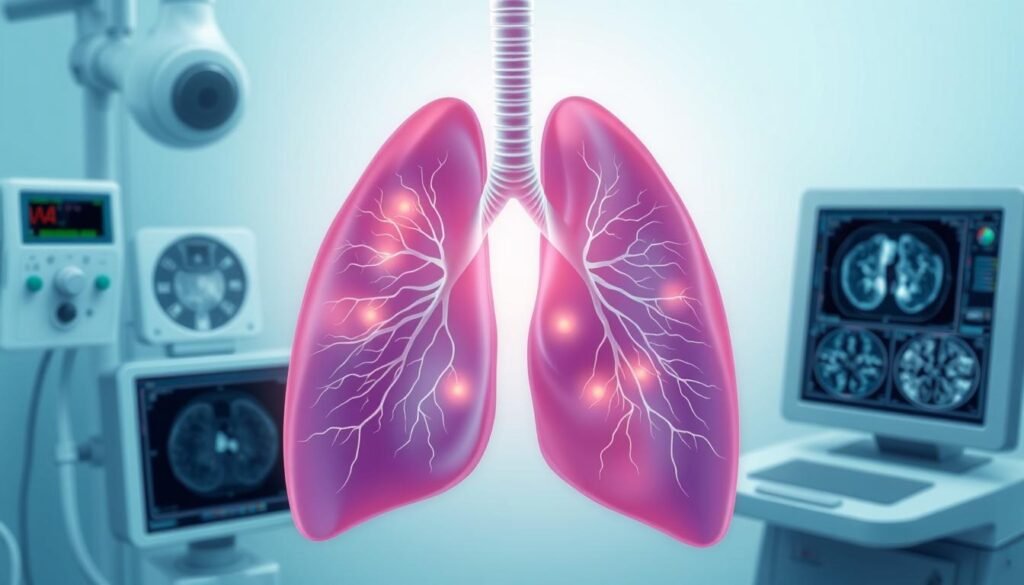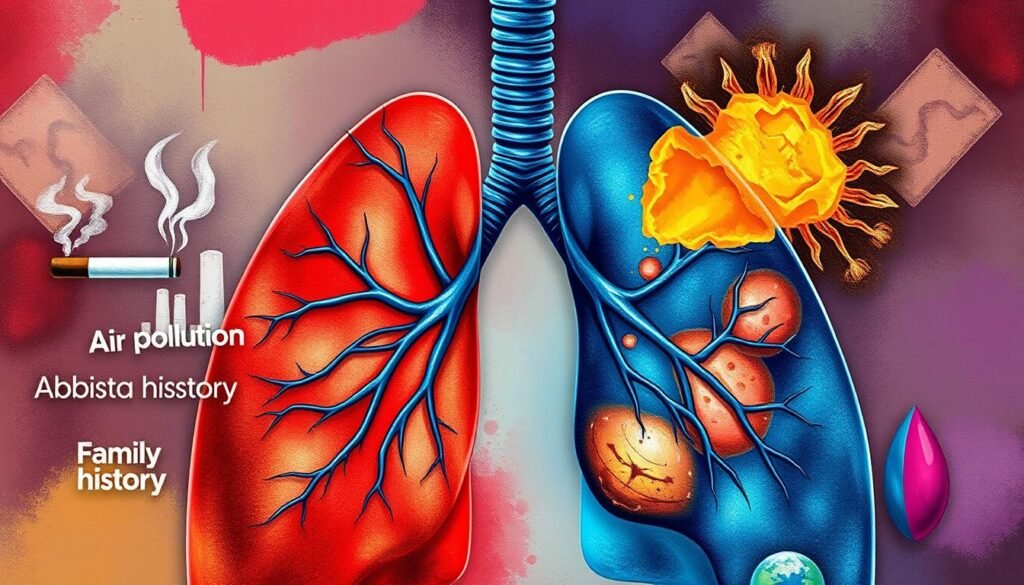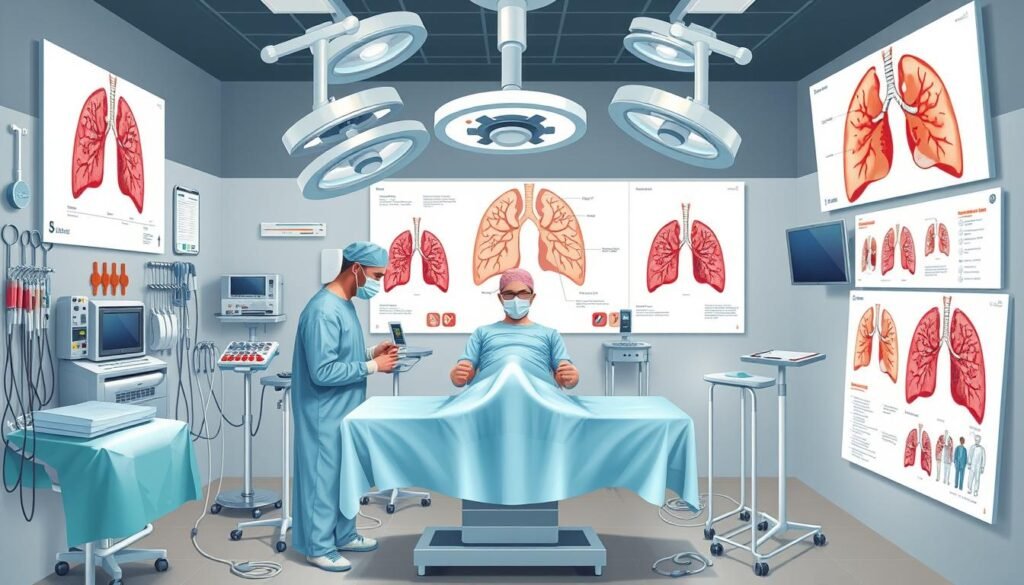About 15% of lung cancer cases are squamous small cell lung cancer. This type starts in the central airways and is closely linked to smoking. Knowing the treatments for this cancer is key because it affects a patient’s future and daily life. Non-small cell lung cancer (NSCLC) includes squamous cell carcinoma. It is the most common lung cancer type, requiring a deep dive into diagnosis, symptoms, and risks.
Patients and their supporters must understand the different treatments for this serious disease. This article aims to guide you through the treatment’s complexities and finer points. It will help you make wise health decisions.
Key Takeaways
- Squamous small cell lung cancer accounts for 15% of lung cancer cases.
- Smoking is a primary risk factor for this aggressive cancer.
- Non-small cell lung cancer includes adenocarcinoma, squamous cell carcinoma, and large cell carcinoma.
- This cancer type grows quickly, so diagnosis and treatment need to be prompt.
- Treatment options can include chemotherapy, radiation, and immunotherapy to help manage symptoms and extend life.
What is Squamous Cell Lung Cancer?
Squamous cell lung cancer is a kind of non-small cell lung cancer. It makes up about 30% of lung cancer cases. It starts in the squamous cells that line the airways.
Most of these cancers come from smoking for a long time. Over 90% of women and 80% of men with this cancer smoked.
Spotting squamous cell carcinoma early is hard because it shows few signs at first. A lot of people find out they have it after it’s grown a lot. Tests like scans and biopsies help doctors confirm the cancer.
It’s important to know the risks, like smoking, asbestos, and family history. This knowledge can help catch the disease early.
Every year, about 85,000 people in the U.S. are told they have squamous cell carcinoma. High numbers show how big of an issue this cancer is. Survival rates and the tough fight against it highlight the need to understand this disease.
Differences Between Squamous Cell Lung Cancer and Small Cell Lung Cancer
It’s important to know the differences between squamous cell lung cancer and small cell lung cancer. Squamous cell lung cancer is a type of non-small cell lung cancer. It usually grows slower and is a big part of lung cancer cases. On the other hand, small cell lung cancer is more aggressive and makes up about 10% to 15% of cases.
The link to smoking is different for these cancers. Squamous cell lung cancer is often connected to tobacco use. Meanwhile, small cell lung cancer is mainly tied to heavy smoking. This also affects how they’re treated. Surgery and targeted therapies might be used for squamous cell lung cancer. This shows it may be caught and treated in one area. Small cell lung cancer, though, spreads quickly. So, it often needs strong treatment with chemotherapy and radiation right away.
Each cancer type has unique traits that influence how they’re managed. Knowing these differences helps people look for the right treatment. It also helps them to stand up for their own health care.
Symptoms of Squamous Small Cell Lung Cancer
It’s vital to recognize the signs of squamous small cell lung cancer early for effective treatment. People might notice several symptoms that need attention. Since these symptoms can be mistaken for less serious conditions, understanding them is critical for quick action.
Common Symptoms Experienced
Individuals with this type of lung cancer may experience symptoms like:
- Persistent cough
- Chest pain
- Shortness of breath
- Coughing up blood
- Recurring lung infections
- Hoarseness
- Weight loss
- Fatigue
These symptoms can look a lot like those of other lung problems. It’s crucial for people to recognize these signs to get help early.
When to Seek Medical Attention
If you have any ongoing symptoms, such as:
- Unexplained weight loss
- Severe cough
- Difficulty breathing
Given how serious lung cancer can be, those with a heavy smoking history or exposure to risks should see a doctor. This includes exposure to asbestos or secondhand smoke.
Understanding Lung Cancer Diagnosis
Lung cancer is a big health issue in the United States. It’s the third most common cancer there. Every year, about 235,000 people find out they have lung cancer. Finding it early and accurately can lead really improve chances of survival. In fact, finding it early can mean a survival rate of over 90%.
To figure out if someone has lung cancer, doctors use special tests. These might include diagnostic tests for lung cancer like X-rays, CT scans, and PET scans. These tests help see if there’s something wrong in the lungs. Often, doctors will also do a biopsy. This is when they take a small piece of lung tissue to check for cancer cells. This step is crucial not only to confirm cancer but also to figure out how advanced it is. Knowing this helps doctors make a good plan for treatment.

Staging tests are a key part of diagnosing lung cancer too. Doctors might use MRI and bone scans to see how far the cancer has spread. This helps them put the cancer into a stage, from 1 to 4. For a certain kind of lung cancer, stages might be called limited or extensive. Getting this right helps make sure patients get the best treatment for their specific situation.
Stages of Squamous Small Cell Lung Cancer
Understanding lung cancer stages helps in managing and treating it. The TNM system classifies squamous small cell lung cancer stages. It shows how much the cancer has spread. This is vital for doctors to plan the best treatment.
Categorizing Cancer’s Advancement
The TNM system details the stages of squamous small cell lung cancer from 0 to IV. Let’s look at what each stage means:
- Stage 0: Cancer cells are present but haven’t spread to nearby tissues.
- Stage I: Cancer is in the lung and may have reached close tissues but not the lymph nodes.
- Stage II: The cancer has spread to close lymph nodes.
- Stage III: It’s moved to nearby lymph nodes and maybe to some tissues around.
- Stage IV: The cancer has spread to other organs far from the lungs.
Importance of Staging in Treatment Plans
The stage of cancer is key in planning lung cancer treatment. It influences the therapies and medicines used. Knowing the stage helps doctors create better treatments. This can lead to better survival rates for patients.
For example, early-stage lung cancer has a five-year survival rate of about 62.8%. But, if the cancer has spread far, the rate drops to 8%. Staging is crucial for deciding on the best treatment approach.
Lung Cancer Risk Factors
Lung cancer risk factors are crucial in developing squamous small cell lung cancer. Smoking is the biggest cause, linked to about 90% of cases. Many smokers, around 70%, want to quit, but only 7% achieve this each year. Knowing the risks helps in taking steps to prevent it.
Age and family history affect lung cancer chances too. Having relatives with lung cancer increases your risk. Dangerous substances like asbestos, radon, and secondhand smoke also pose significant dangers. These are common in many jobs and places, making them a widespread concern.
Trying to quit smoking can be more successful with the right help. Using medications like varenicline and getting counseling can greatly improve your chances. Sadly, less than a third of quitters get support, and only 5% have access to both medication and counseling. Resources like the National Institutes of Health Quitline are vital for those wanting to quit.

| Risk Factor | Impact on Squamous Small Cell Lung Cancer |
|---|---|
| Tobacco Use | Accounts for up to 90% of lung cancer cases |
| Age | Increased risk in older adults |
| Family History | Higher likelihood with familial cancer backgrounds |
| Exposure to Carcinogens | Includes asbestos, radon, and secondhand smoke |
Available Treatment Options for Squamous Small Cell Lung Cancer
People fighting squamous small cell lung cancer have several choices for treatment. These options are based on their health and the cancer stage. Doctors often combine surgery, chemotherapy, radiation, and immunotherapy. This team effort makes sure the treatment fits the patient well.
Combining Treatment Modalities
For this kind of lung cancer, doctors use a mix of treatments. The goal is to get the best results and help patients feel better. Some common methods include:
- Surgery: Removing a part of the lung, called a lobectomy, is common.
- Chemotherapy: This method attacks cancer cells all over the body.
- Radiation Therapy: EBRT targets the cancer directly, sparing healthy areas.
- Immunotherapy: It boosts the body’s own fight against cancer cells.
Considerations for Treatment Plans
Doctors think carefully about each patient’s needs and wishes. They consider overall health, treatment side effects, and patient input. It helps if patients understand their choices. Age, health history, and certain proteins affect the plan.
Using resources like trusted cancer websites, patients can learn more and have a say in their care. A thorough plan is key to fighting squamous small cell lung cancer.
| Treatment Modality | Description | Potential Benefits |
|---|---|---|
| Surgery | Removal of tumor and surrounding tissue. | Can provide the best chance for a cure if cancer is localized. |
| Chemotherapy | Use of drugs to kill cancer cells. | Effective for systemic treatment and shrinking tumors. |
| Radiation Therapy | Targeted radiation to destroy cancer cells. | Can reduce tumor size and alleviate symptoms. |
| Immunotherapy | Boosts the immune system to fight cancer. | May provide long-lasting responses in some patients. |
Role of Surgery in Treating Squamous Small Cell Lung Cancer
Surgery is key to treating squamous small cell lung cancer, especially if found early. An early diagnosis means lung cancer surgery is more effective. This can greatly improve the chances of a cure. Surgeries like lobectomy, pneumonectomy, and wedge resection are options. The choice depends on the tumor size, its location, and the patient’s lung health.
It’s crucial to look at the patient’s unique situation when thinking about surgical options for squamous cell lung cancer. For early-stage non-small cell lung cancer, surgery can lead to a survival rate of over 60% after five years. This highlights how important early finding is for the patient’s outlook.

Lung surgery types include open lung surgery or less invasive methods like VATS and robotic-assisted surgery. VATS is popular for its shorter recovery and fewer complications. It also has success rates similar to traditional methods.
However, surgery has risks like reactions to anesthesia, bleeding, and infection. Recovery can take weeks to months. It depends on the surgery’s complexity and the patient’s health. Some might need tubes after surgery to help with healing.
The role of surgery in treating this lung cancer type is getting better as techniques improve. This means better treatment chances and survival rates for patients.
| Surgical Option | Description | Recommended In Cases of |
|---|---|---|
| Lobectomy | Removal of a lobe of the lung. | Localized tumors, early-stage diagnosis. |
| Pneumonectomy | Removal of an entire lung. | Large tumors or extensive disease. |
| Wedge Resection | Removal of a small, wedge-shaped portion of lung. | Small tumors or nodules. |
| Video-assisted Thoracoscopic Surgery (VATS) | Minimally invasive technique using small incisions. | Early-stage lung cancer with less invasion. |
| Robotic-assisted Thoracoscopic Surgery (RATS) | Advanced minimally invasive surgery using robotic systems. | Complex cases requiring precision. |
The Use of Radiotherapy in Treatment
Radiotherapy is key in treating squamous small cell lung cancer. It uses high-energy rays to kill cancer cells. This is often done alongside other treatments. It aims to shrink tumors and ease symptoms, making treatment more effective.
How Radiotherapy Works
To understand radiotherapy, it’s important to know the types used for lung cancer. They aim to damage the DNA in cancer cells. By doing this, it stops the cells from growing, helping the patient get better.
Types of Radiotherapy for Lung Cancer
External Beam Radiation Therapy (EBRT) is a common choice. Treatments are given once or twice a day, for five days a week, taking three to seven weeks. Stereotactic Body Radiation Therapy (SBRT) is another method. It gives high doses in fewer sessions, often one to five. This is best for early-stage cancer, avoiding surgery.
Though helpful, radiation therapy can cause side effects. These include skin changes, fatigue, and feeling sick. Some patients might have lung problems, causing trouble breathing or cough. Knowing and managing these side effects is crucial for good care.
| Type of Radiotherapy | Session Frequency | Treatment Duration |
|---|---|---|
| External Beam Radiation Therapy (EBRT) | Once or twice daily | 3 to 7 weeks |
| Stereotactic Body Radiation Therapy (SBRT) | 1 to 5 sessions | Varies |
In summary, radiotherapy plays an important part in lung cancer treatment. It allows for specific treatments that meet the needs of patients with squamous small cell lung cancer.
Understanding Chemotherapy for Lung Cancer
Chemotherapy plays a crucial role in fighting squamous small cell lung cancer. It’s often the choice for patients who can’t have surgery. This treatment attacks cancer cells all over the body. It uses a versatile approach to manage or kill cancer.
Chemotherapy often works alongside radiation, known as chemoradiation. This mix boosts its power. Two-drug combos, like cisplatin or carboplatin with gemcitabine or etoposide, have high success rates. Chemotherapy isn’t just for inoperable cancer; it also shrinks tumors before surgery, clears cancer cells after surgery, and eases pain in late-stage cancer.
Chemotherapy is usually given through shots or IVs. The first treatment for advanced cancer often includes 4 to 6 cycles of combined therapies. Watching how the cancer responds is key. If there’s a good initial response, continuing with the same drugs might work well. But if cancer comes back sooner than expected, doctors may try new drugs or a different approach.
While effective, chemotherapy for lung cancer has side effects, like:
- Low blood cell counts
- Nausea and vomiting
- Fatigue
- Hair loss
- Mouth sores
- Peripheral neuropathy (numbness or tingling in extremities)
To lower risks, like kidney damage from cisplatin, lots of IV fluids are needed before and after doses. Managing side effects well is crucial. Quick communication with doctors can help adjust treatments and make patients more comfortable.
| Chemotherapy Drug Combinations | Indications |
|---|---|
| Cisplatin + Etoposide | Common for treating squamous small cell lung cancer |
| Carboplatin + Etoposide | Standard for advanced lung cancer treatment |
| Cisplatin + Gemcitabine | Used for patients with specific lung cancer types |
| Docetaxel + Paclitaxel | Alternative options based on patient needs |
| Pemetrexed + Other Agents | For advanced or metastatic lung cancer |
Treating squamous small cell lung cancer involves different strategies and drug combinations. This lets healthcare teams offer custom solutions for each patient’s unique needs.
Emerging Treatments and Clinical Trials
The world of lung cancer treatment is changing fast because of new ideas in immunotherapy. Researchers are looking into special drugs. These drugs could make our immune system fight lung cancer better, especially a type called squamous small cell lung cancer. They are also trying these drugs with usual treatments to see if they work better together and make patients feel better.
Current Research in Immunotherapy
Studies are testing new ways to use treatments like pembrolizumab and atezolizumab. These treatments, when used with chemo, have helped more patients improve – the success rate jumped from 38.4% to 57.9%. Also, people lived longer – up to two years or more – when they got immunotherapy. Scientists are excited about these new lung cancer that mix old and new methods.
Future Directions in Lung Cancer Treatment
Experts are now focusing on treatments designed just for one person. The goal is to make treatments better by finding out more about each patient’s unique cancer. They’re using tech like artificial intelligence to figure this out. With new types of tests, they aim to make big leaps in treatment. There’s hope that these new ways will help people with lung cancer live longer and have a better life.
| Treatment Type | Overall Response Rate | Median Overall Survival (Months) | Progression-Free Survival (Months) |
|---|---|---|---|
| Pembrolizumab + Chemotherapy | 57.9% | Not specified | Not specified |
| Atezolizumab + Chemotherapy | Not specified | Not specified | 6.3 |
| Nivolumab + Ipilimumab | Not specified | 17.1 | Not specified |
Conclusion
Understanding treatment for squamous small cell lung cancer is crucial for patients and their families. It’s important to know the symptoms, diagnosis, staging, and risks. This knowledge helps in making informed decisions.
Patients become empowered to manage their health with their doctors. This approach boosts their confidence in facing lung cancer.
The path through lung cancer treatment is challenging. Yet, there is hope thanks to advancements in chemotherapy and immunotherapy. Researchers are also working on treatments tailored to individual genetic profiles.
Fighting lung cancer requires teamwork, ongoing research, and support from everyone. For in-depth information, visit this resource. Together, we aim to reduce the death rate and improve the lives of those affected.